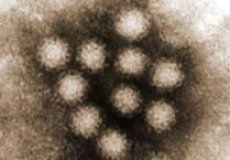Medical expert of the article
New publications
Norwalk viruses
Last reviewed: 04.07.2025

All iLive content is medically reviewed or fact checked to ensure as much factual accuracy as possible.
We have strict sourcing guidelines and only link to reputable media sites, academic research institutions and, whenever possible, medically peer reviewed studies. Note that the numbers in parentheses ([1], [2], etc.) are clickable links to these studies.
If you feel that any of our content is inaccurate, out-of-date, or otherwise questionable, please select it and press Ctrl + Enter.

In 1968, during an outbreak of acute gastroenteritis among schoolchildren and teachers in the city of Norwolk (USA), the causative agent of this outbreak was discovered - a virus called Norwolk. It was identified using the method of immune electron microscopy. The virus has a spherical shape and a diameter of 27-32 nm. Similar viruses were discovered in many other outbreaks of gastroenteritis in England, the USA, and Australia.
Antigenically, they were found to be heterogeneous, with at least 4 serovariants identified. The genome is represented by single-stranded, non-fragmented RNA of positive polarity. The virus is classified as belonging to the Caliciviridae family; these are the most common causative agents of gastroenteritis in children over 4 years of age and in adults. The virus is excreted in the first 48-72 hours after the disease, and is very stable in the external environment. It is spread by the fecal-oral route through contaminated water and food.
The incubation period is 18-48 hours. The onset of the disease is acute, vomiting in 70% of cases, diarrhea in 65%. The disease lasts 2-3 days. In elderly people, a fatal outcome is possible. Diagnosis of the disease is difficult due to the lack of laboratory test systems and the impossibility of culturing the virus in vitro.


 [
[